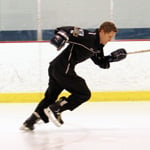Many of you have been told to start on your toes. But do you know why and when and how to start on your toes?
Starting on skates are comparable to sprint runners starting out of the blocks. In order to get going quickly and explosively they take the first few steps on the balls of their feet. They do not start on their heels! In hockey we need to do the same thing. What we call "the toes of the skates" are in actuality the front two to three inches of the inside edges (the balls of the feet).
Explosive starts (whether in running or skating) involve three elements: Quickness, Power, and Distance. Starting on the toes accomplishes the first element, quickness. However, quick feet alone are insufficient – it is imperative to go somewhere (cover distance). Powerful, explosive pushes with the body weight projected well outward (toward the desired line of travel) help to achieve distance.
When should we start on our toes?
Although toe starts are taught at all Laura Stamm Power Skating clinic and although we emphasize their importance, we often watch players (who do great toe starts at our clinics) start on their full blades in games. This may be from lack of concentration or from sporadic practice during the season. There's no use learning how to do toe starts (or any other maneuver) if you don't practice them all the time and then incorporate them in game situations.
I call toe starts the "escape valve". Anytime you need to get away, start on your toes. From a face-off, when changing gears from slow to fast, when racing for the puck, when trying for a breakaway, or in any situation when an instant getaway is crucial, get up on your toes and GO! To assure you will use toe starts in games, you must use them in all practice situations as well. When the coach blows the whistle for you to start out from a stopped position, start on your toes. Every time! This is the only way to make them "an automatic" response.
How to execute toe starts:
In order to get up on the toes you have to keep your heels off the ice. If your heels touch the ice the skates are forced to glide. Gliding is a process of deceleration; the result is that you will feel as though you are stuck in the mud.
We can't use our toes on skates in the same way as we do on running shoes. Because we are on ice we need to grip, or dig into, the ice to prevent the skates from slipping. For the edge to grip the ice it must be on the ice at an angle that is sideways to the line of travel; thus the famous "V" position of the skates.

With your feet and legs in a duck-like (what I refer to as the V-Diamond) position, try to take the first two or three steps on your toes (on the fronts of the inside edges). Maintain a low and forward body angle. Leap out; don't jump up. Remember: the idea is to cover distance, not height! Try to keep your heels off the ice during these initial running steps.
The player with the quickest and most explosive starts has the advantage when racing an opponent or when breaking out with the puck. Keep in mind that it takes years of training and practice to master these starts. You will probably have to do many thousands of them before you can finally do them instinctively and in games.
Practice does not make perfect – only perfect practice makes perfect. So practice toe starts perfectly, and don't be concerned if you take a lot of falls during this process.
by Laura Stamm, © May, 2003